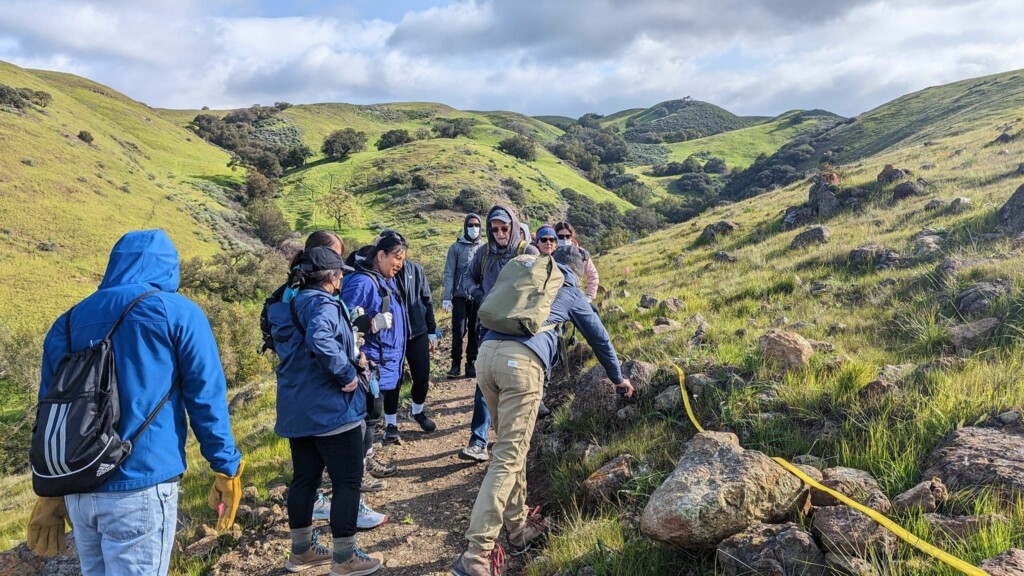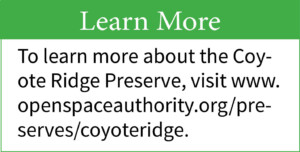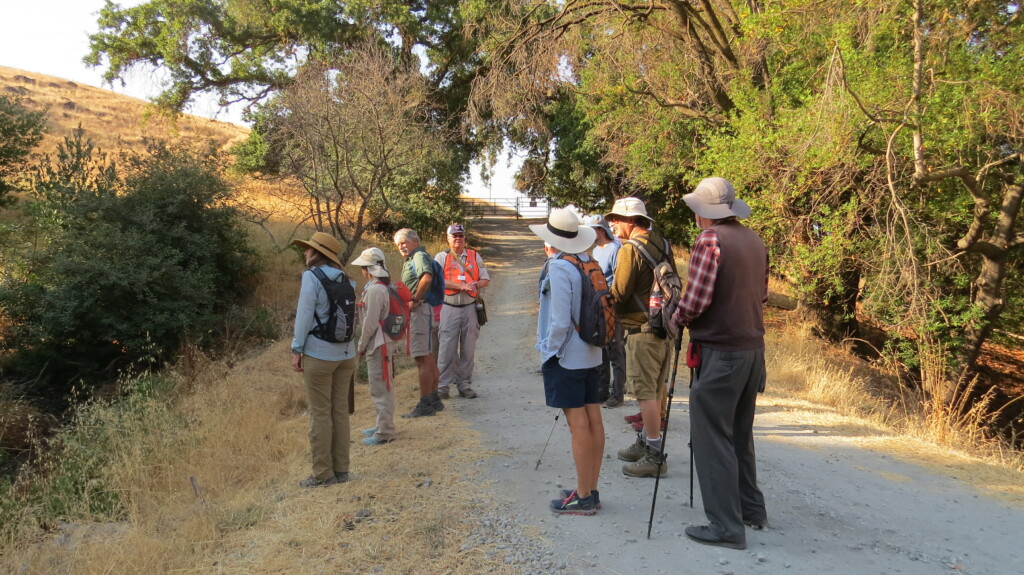Main story: Coyote Ridge wilderness opens for public to explore
OSA’s 1,849-acre grassland preserve has panoramic views of South Valley
![]()

By Calvin Nuttall
High above Silicon Valley in the Diablo Range lies a pristine wilderness a world away from the urban jungle, but less than a 20-minute drive from downtown Gilroy.
 The newly opened Máyyan ‘Ooyákma/Coyote Ridge Open Space Preserve offers visitors 1,859 acres of unspoiled serpentine grasslands, home to rare butterflies, wildflowers and other species. Hikers can take in breathtaking panoramic views of the South Valley from scenic trails winding through a biodiversity hotspot serving an oasis for nature and outdoor enthusiasts.
The newly opened Máyyan ‘Ooyákma/Coyote Ridge Open Space Preserve offers visitors 1,859 acres of unspoiled serpentine grasslands, home to rare butterflies, wildflowers and other species. Hikers can take in breathtaking panoramic views of the South Valley from scenic trails winding through a biodiversity hotspot serving an oasis for nature and outdoor enthusiasts.
“This property is a biological gem,” said Lucas Shellhammer, planning manager at the Open Space Authority. “I wouldn’t be exaggerating to say this area is some of the most sensitive habitat, if not the most sensitive and important habitat in the entire South Bay. That’s why many agencies and nonprofits are looking to protect this land.”
The view from Coyote Ridge is awe-inspiring. Visitors who have lived in the Bay Area all their lives may have never seen the region from the preserve’s unique vantage point, situated high on the east flank of the valley.
“It’s absolutely breathtaking,” said Andres Campusano, the project’s supervising open space technician. “If people get out onto the Butterfly Trail, they’ll get onto a mile and a half of hand-built trail which then leads up to the ridge where you can get beautiful views of Coyote Valley. On a clear day, you can see clear across to and wave at our friends on Mount Umunhum, straight across Coyote Valley.”
The preserve opened for free to the public Thursday, Aug. 31. Five miles of new trails, including a new three-mile segment of the Bay Area Ridge Trail, will be accessible on a shifting schedule intended to balance recreation with protection for the sensitive ecology in the area.
The preserve connects more than a million acres of core wildlife habitat between the Santa Cruz Mountains and the Diablo Range, creating a crucial wildlife corridor.
 “Because it is the closest point between the Diablo Range and the Santa Cruz Range, a lot of the species are very isolated, because they’re penned in by development on one side and the ocean on the other,” Shellhammer said. “Allowing animals to move across that corridor is one of the primary goals of the Open Space Authority.”
“Because it is the closest point between the Diablo Range and the Santa Cruz Range, a lot of the species are very isolated, because they’re penned in by development on one side and the ocean on the other,” Shellhammer said. “Allowing animals to move across that corridor is one of the primary goals of the Open Space Authority.”
Three of the preserve’s trails are located inside a Habitat Protection Area where 1,830 acres are enrolled in the Santa Clara Valley Habitat Plan. To protect this sensitive land from excessive human impact, a free annual Butterfly Pass is required year-round for public access.
“Lucas and his team have designed a gorgeous staging area,” Campusano said. “They surrounded it with serpentine rock, which helps tell the story of why that landscape is so precious.”
 Many endangered species make their home in the preserve’s rare serpentine grasslands, some of which are near extinction. Among them are the Bay checkerspot butterfly, the Metcalf Canyon jewelflower, California red-legged frogs and tiger salamanders, tule elk, Western burrowing owls, golden eagles and other birds of prey.
Many endangered species make their home in the preserve’s rare serpentine grasslands, some of which are near extinction. Among them are the Bay checkerspot butterfly, the Metcalf Canyon jewelflower, California red-legged frogs and tiger salamanders, tule elk, Western burrowing owls, golden eagles and other birds of prey.
“Máyyan ‘Ooyákma is a biodiversity hotspot,” said Andrea Mackenzie, general manager of the Open Space Authority, in a press release. “Its opening as a preserve presents an unparalleled opportunity to educate the public about the importance of protecting habitats for endangered plants and animals and helping them adapt to a changing climate. This place will serve as an inspiring outdoor classroom, welcoming people of all ages and abilities to learn about wildlife, climate science and how to responsibly care for the land.”
The preserve is located within the traditional territory of the Muwekma Ohlone Tribe. The OSA decided to involve the tribe in their work of telling the land’s story because of the importance of its cultural connection. Many of the informational signs within the preserve reflect this collaboration including the name “Máyyan ‘Ooyákma.”
“One of the interests of the Muwekma is in restoring their language, and the actual name of the land of the preserve was lost to time,” Shellhammer said. “‘Máyyan ‘Ooyákma’ is actually a literal translation of ‘Coyote Ridge’ provided by the tribe. It was important to them to let people know through the naming process that the tribe is still around, it’s not a thing of the past.”
Facilities include an ADA restroom, paved walkways, seating and shaded picnic areas and overlooks and multilingual educational interpretative signage.
 “We have a really robust educational/interpretive program,” Shellhammer said. “We have a number of panels that tell the stories of the endemic species. The preserve is right off the freeway and 10 minutes from downtown San Jose. The ability to bring students out there is something we programmed into the design.”
“We have a really robust educational/interpretive program,” Shellhammer said. “We have a number of panels that tell the stories of the endemic species. The preserve is right off the freeway and 10 minutes from downtown San Jose. The ability to bring students out there is something we programmed into the design.”
In addition to hiking and mountain biking, horseback riding is also welcome. However, the parking lot is relatively small for use with a horse trailer, so equestrians are asked to make a reservation.
“We do have a number of folks who ride into other places like Coyote Valley Open Space Preserve from neighboring properties,” said Charlotte Graham, OSA’s public information officer. “I’m one of those people! There could be folks riding their horses in, and they are welcome.”
Because of the seasonal needs of the sensitive wildlife in the preserve, the preserve schedule will shift throughout the year to minimize stress on the ecosystem caused by human impact. In particular, access will be limited to docent-led weekend hikes only during wildflower season.
“March through May, things are going to be a little bit different,” Graham said. “There won’t be any bike or equestrian access on the weekends when we’re requiring those for docent-led tours.”
Due to the sensitivity of the environment, dogs and drones are not allowed.
Calvin Nuttall is a Morgan Hill-based freelance writer and columnist.

